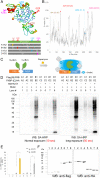Contact-ID, a tool for profiling organelle contact sites, reveals regulatory proteins of mitochondrial-associated membrane formation
- PMID: 32414919
- PMCID: PMC7275737
- DOI: 10.1073/pnas.1916584117
Contact-ID, a tool for profiling organelle contact sites, reveals regulatory proteins of mitochondrial-associated membrane formation
Erratum in
-
Correction for Kwak et al., Contact-ID, a tool for profiling organelle contact sites, reveals regulatory proteins of mitochondrial-associated membrane formation.Proc Natl Acad Sci U S A. 2020 Aug 11;117(32):19605. doi: 10.1073/pnas.2014254117. Epub 2020 Aug 3. Proc Natl Acad Sci U S A. 2020. PMID: 32747550 Free PMC article. No abstract available.
Abstract
The mitochondria-associated membrane (MAM) has emerged as a cellular signaling hub regulating various cellular processes. However, its molecular components remain unclear owing to lack of reliable methods to purify the intact MAM proteome in a physiological context. Here, we introduce Contact-ID, a split-pair system of BioID with strong activity, for identification of the MAM proteome in live cells. Contact-ID specifically labeled proteins proximal to the contact sites of the endoplasmic reticulum (ER) and mitochondria, and thereby identified 115 MAM-specific proteins. The identified MAM proteins were largely annotated with the outer mitochondrial membrane (OMM) and ER membrane proteins with MAM-related functions: e.g., FKBP8, an OMM protein, facilitated MAM formation and local calcium transport at the MAM. Furthermore, the definitive identification of biotinylation sites revealed membrane topologies of 85 integral membrane proteins. Contact-ID revealed regulatory proteins for MAM formation and could be reliably utilized to profile the proteome at any organelle-membrane contact sites in live cells.
Keywords: FKBP8; membrane contact site; membrane protein topology; mitochondria-associated membrane (MAM); proximity labeling.
Conflict of interest statement
The authors declare no competing interest.
Figures







References
-
- Elbaz Y., Schuldiner M., Staying in touch: The molecular era of organelle contact sites. Trends Biochem. Sci. 36, 616–623 (2011). - PubMed
-
- Rizzuto R., et al. , Close contacts with the endoplasmic reticulum as determinants of mitochondrial Ca2+ responses. Science 280, 1763–1766 (1998). - PubMed
-
- Vance J. E., Phospholipid synthesis in a membrane fraction associated with mitochondria. J. Biol. Chem. 265, 7248–7256 (1990). - PubMed
Publication types
MeSH terms
Substances
LinkOut - more resources
Full Text Sources
Other Literature Sources
Research Materials

